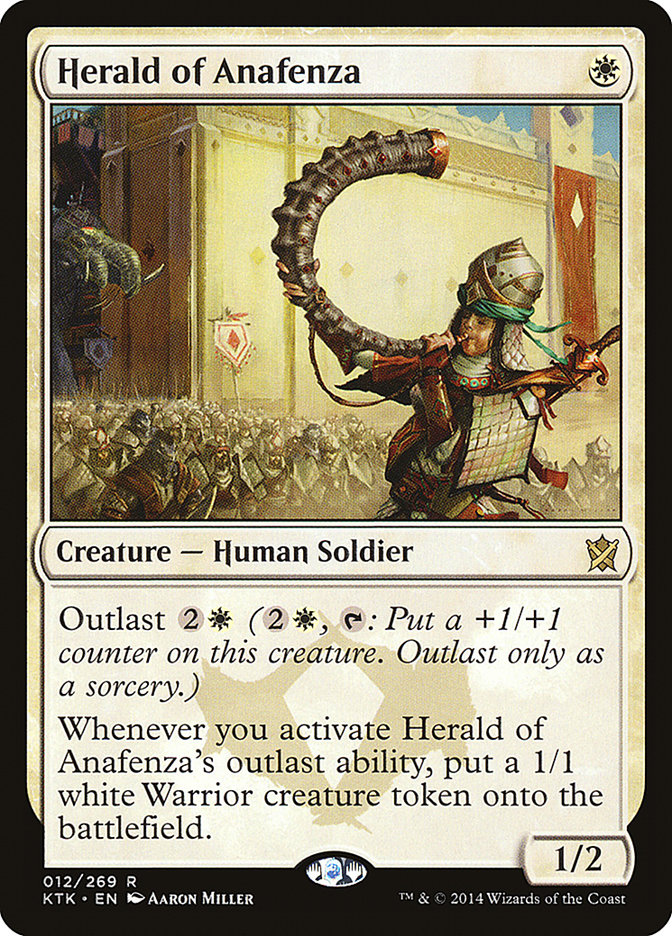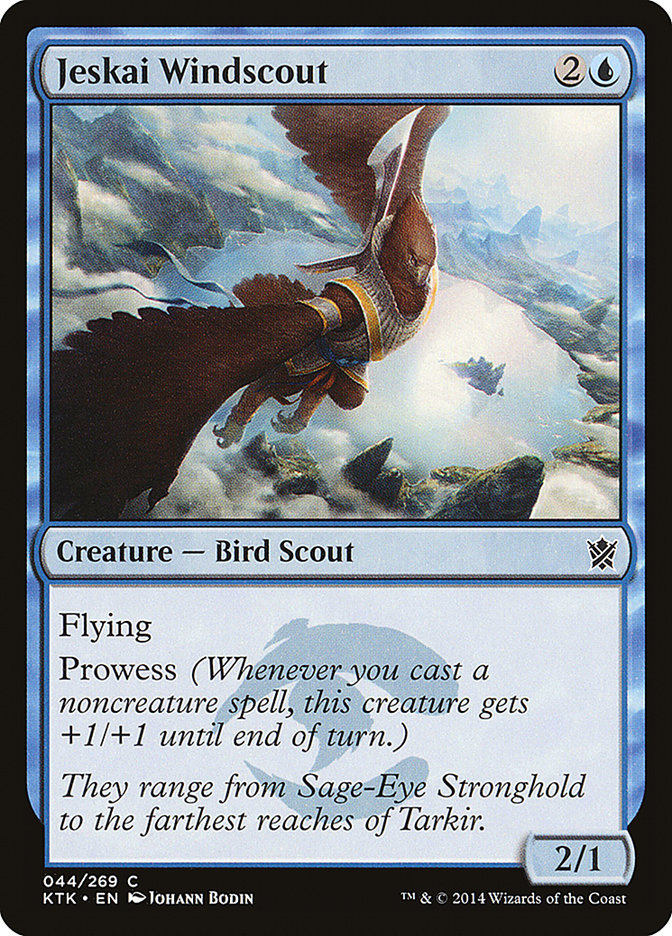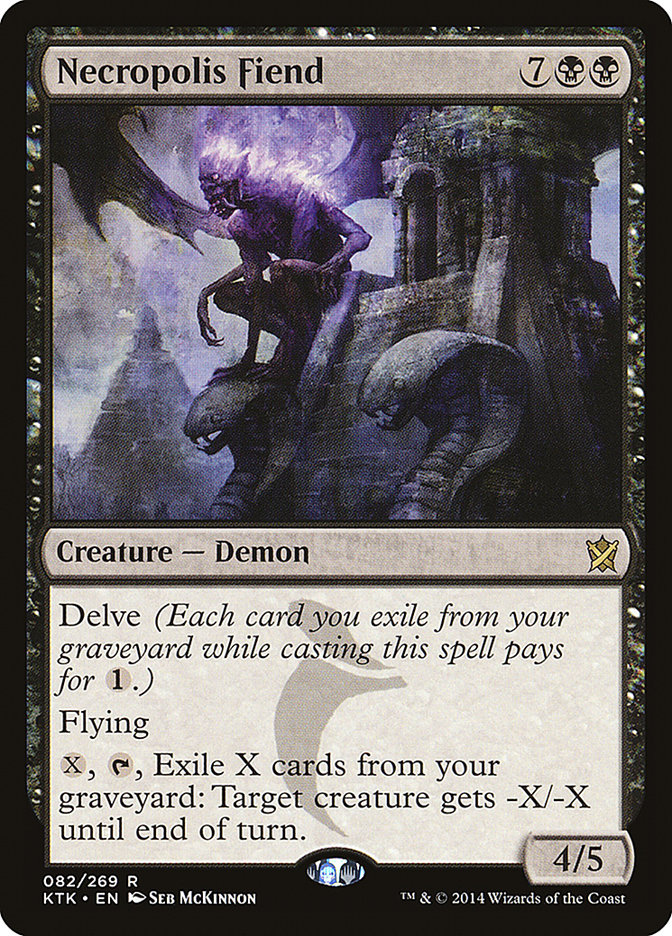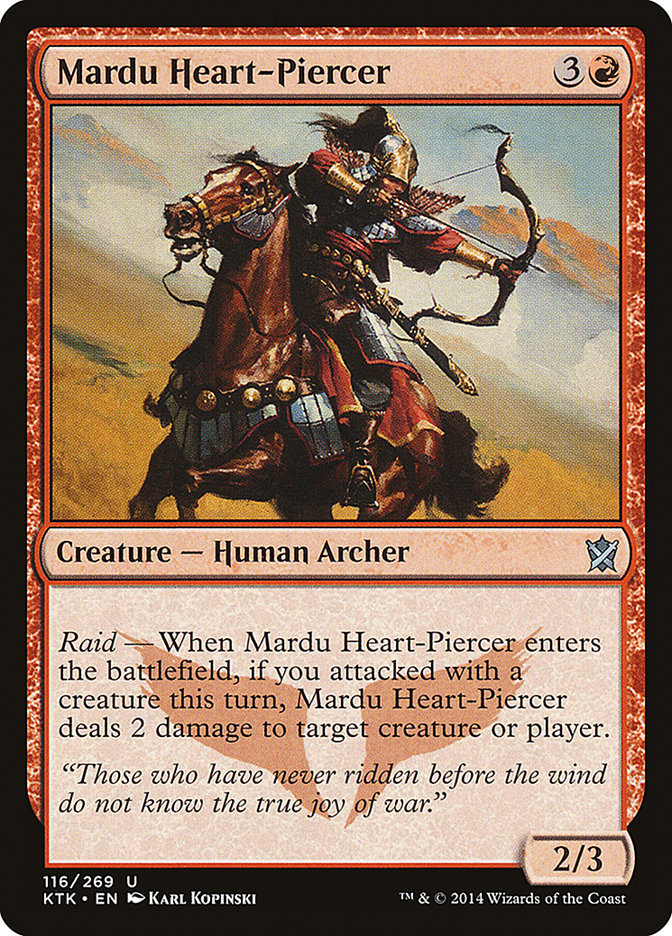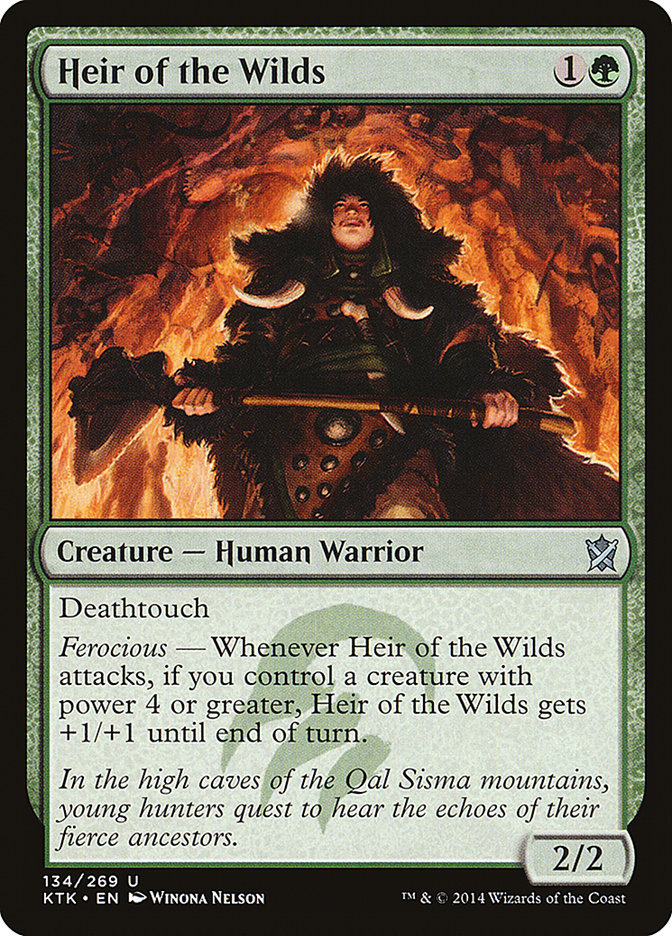I’m pretty excited about Khans of Tarkir. The fetchland reprints aren’t that important to my impression of the set as a whole–we need dual lands of some
varieties, and the exact mechanics aren’t that important to how the set plays. What I’m into is exploring the definitions of the wedges and seeing how the
mechanics of these three color groups will play together and what kinds of strategies will be pushed in each clan.
Abzan’s mechanic is called Outlast. They couldn’t really have been more explicit about what Abzan is trying to do than that. This feels like it puts a
strong emphasis on the Orzhov component of this clan, but then, thinking about it more, it definitely fits the Golgari attrition model and the Selesnya
build-up plan.
At first, “my guys have tap abilities that make them bigger” felt kind of weird and narrow as a mechanic, but cards like Herald of Anafenza feel very GWB
while being White–it’s like a Selesnya Evangel that gets bigger in a way that’s reminiscent of scavenge. The mechanic makes it very clear that you want to
have a lot of creatures in play, and you mostly want to be blocking with them, and you’re getting value every turn out of using them, so stalls favor you.
Selesnya, Golgari, and Orzhov all played just like this! They all wanted board stalls with lots of creatures in play where they could hang out and gain
value until their opponent was wildly outmatched and then they could incidentally win the game. I love it. This is a strategy I’ve loved drafting in Return
to Ravnica, and it looks like something I’ll be really happy doing in this set, but I’m also excited to see how the different strategies the clans push
matchup and play against each other.
Jeskai is the “spell clan”–its mechanic goes on creatures, but it asks you to play noncreatures. This means you’ll be building decks with the kinds of
constraints that cards like Delver of Secrets, Snapcaster Mage, and Augur of Bolas put on decks. You want to play a lot of creatures that are awesome when
your deck is full of spells, because you really want to play one of those creatures early, but you also want to play a lot of spells to make them good. The
fewer creatures you play, the better each one is, but the first few creatures are really awesome.
This feels primarily Izzet, since we’re basically just looking at a bunch of Wee Dragonauts. Azorius has had access to tempo decks that play kind of like
this, but it’s a fringe strategy. In fact, even as an Izzet strategy this is much more similar to how Izzet plays in Limited than what people usually do
when they play U/R in Constructed, which more often than not, ends up being combo focused. As for R/W, that’s a much more creature centric pairing–Boros
most recently had battalion, which basically wanted you to play as many creatures as possible. Certainly, Blue feels like the primary mechanical color of
Jeskai on first impressions.
This means Jeskai seems like much less of a “home run”/perfect implementation to me than Abzan, and the individual cards are going to have to do a lot of
work to pull it together for me. I like having a spell-focused strategy in Limited, so I think I’ll like Jeskai; I just feel like it’s less of a natural
direction for these colors to take and more like design chose an arbitrary thing that these colors could focus on and ran with it.
On a purely theoretical, abstract level, it feels like Jeskai should kind of be a natural foil to Abzan in that Abzan is fundamentally about blocking and
creating a stall, and Jeskai isn’t necessarily trying to attack, and when it is, it’s attacking with creatures that are hard to block, either because of
evasion or because that’s the nature of the prowess keyword. Also, Abzan is looking to take advantage of a stall to give it time, while Jeskai is likely to
have a very tempo and evasion-oriented strategy, which should play well against cards that need time to set up.
Sultai is another clan I like a lot (actually, I’m pretty into all of them). Sultai feels mechanically different than Abzan but strategically very similar.
This is actually good, in that both are very natural fits. When I draft BUG I generally expect my decks to play out very similarly to how I expect most of
my GWB decks to play out. Self-mill is definitely the kind of thing I expect to be doing in this color combination, especially after having played with
Innistrad, but it’s not at all Limited to that. In Theros, I was a fan of occasionally combining Satyr Wayfinder with Mnemonic Wall and Rescue from the
Underworld, for example.
Delve is a pretty interesting mechanic. Cost reducing mechanics in general are very potent, but this one has a really interesting tension. With Affinity,
once you hit critical mass, everything’s free and all the cards play off each other, and you just want as many as possible. Delve has deckbuilding
implications that are more like what I was describing with Jeskai–your first few delve cards are going to be totally awesome, but they’re all eating the
same resource, and the more you play, the worse each is. On the other hand, the more you play, the more you can justify going out of your way to support
the mechanic, and the more likely you are to get rewarded.
Delve is a really interesting mechanic in draft–theoretically, people drafting anything but Sultai might value any given delve card they see in a
pack more highly than someone who’s actually drafting Sultai, because the Sultai player can take any delve card, but someone who’s drafting Jeskai, for
example, can only take a blue delve card. Because the first delve card is the best delve card, a Jeskai deck would probably really like to have a blue
Sultai card with delve. The Sultai drafter can afford to wait, taking an enabler or some other card over it since they’ll have more options on delve cards
later. On the other hand, once you’ve taken a delve card, you’re more likely to want to take other Sultai cards that will help fill your graveyard to
enable your delve card, and then, having enablers, you’ll probably want another delve card–that’s how they hook you.
As for actual gameplay, this is interesting to compare to Abzan. Sultai doesn’t naturally benefit from waiting around indefinitely, but it does take some
time to set up. The big difference is that Abzan wants a cluttered board with as many things in play as possible, and Sultai is likely to want to trade
cards at every opportunity to get things into the graveyard and win the game with a powerful delve card that comes out early on an empty board. The easiest
way to trade cards is with removal, so Sultai will value removal more highly than Abzan. Obviously, any controlling strategy is going to need removal, so
Abzan will still have to take it highly, but Sultai will want mediocre removal more than Abzan. In general, the more removal the Sultai deck has, the
better its matchup against Abzan will be. Abzan having a lot of removal won’t help it much against Sultai though.
Sultai Charm is particularly interesting–as I just mentioned, Sultai is always looking to trade cards, so a versatile answer card is great, but it’s easy
to underestimate the third mode. Remember that this is a strategy that’s very well set up to take advantage of reanimation, specifically. In Standard the
interaction between Sultai Charm, Satyr Wayfinder, and Endless Obedience is noteworthy. Including Green in your U/B Reanimator deck means you’re more
likely to have random early creatures in play to convoke with, and having easy access to a card that lets you discard a fatty that you draw that you were
hoping to mill is extremely important to that kind of strategy, and something that didn’t exist in Theros block.
As for Sultai against Jeskai, theoretically Sultai should always be the attrition deck, so the more the Jeskai deck is focused on killing Sultai’s
cards instead of pursuing its own gameplan, the worse it will be. Jeskai is hoping to minimize interaction, likely by killing Sultai while they’re setting
up and playing green and black creatures that are intended as roadblocks, but Jeskai can just fly over. I expect Jeskai to have access to bounce and other
tempo plays (like the Frost Lynx effect), both of which are awesome against Delve creatures, which take a large investment to get into play. Bounce in
particular is absolutely devastating against delve. I still believe these games being interesting, and it’s not clear to me which clan should be favored,
which is great.
Mardu is another clan I have some personal affiliation with thanks to my work on Zombies in Legacy and The Aristocrats in Standard. I’ve been playing Magic
long enough that I have some history with every color combination, but this is definitely one that stands out, despite not including Blue, my favorite
color. I really like the direction they’ve gone with Mardu. It’s not exactly how I build my Mardu decks, but I wouldn’t want it to be–my Mardu decks are
basically Orzhov decks with a splash of red for some reason, but they’re relatively focused on attrition in a very B/W way. Proper design for Mardu as a
clan needs to more evenly incorporate Red, which this design does.
R/W/B has always been kind of a “fodder aggro” strategy, or at least it’s had access to or roots in that kind of thing. Make a bunch of tokens, pump them,
don’t care much if some of them die because each required such a small investment. This is what Mogg War Marshal, Lingering Souls, Blood Artist,
Bloodghast, Doomed Traveler, and all my other favorite R/W/B cards are about, and it’s entirely consistent with Mardu’s gameplan. The raid mechanic wants
you to attack every turn. Mardu’s creatures are small and not particularly evasive, sometimes the attacks will end badly for some of the creatures, but
that’s fine. It might be worth throwing away a creature to trigger the raid ability on the next creature you play. After all, the creature you’re throwing
away likely already did what you needed it to do when it came into play with its own raid trigger. Raid also encourages you to curve out and to try to stay
ahead, to get under your opponent. Sometimes your opponent will manage to shut your offense down with good blockers, and that’s where cards like Ankle
Shanker shine (and whatever Inspired Charge variant will inevitably exist in this set).
Mardu should theoretically have a bad matchup against Abzan–Mardu wants to attack, and Abzan wants to block, and in general, creatures designed to block
are good against creatures that are designed to attack without evasion. Mardu will need to have and maximize combat tricks that punish blocking to win this
matchup.
Mardu should be great against Sultai, however. Removal is terrible against cheap creatures, tokens, and creatures that do things when they come into play,
which should compose almost all of Mardu’s creatures. Moreover, Sultai’s defenses likely take time to get online, during which Sultai is seriously falling
behind.
Mardu against Jeskai is another one of those matchups that’s more unclear, both are small, potentially aggressive strategies that should be comparable and
evenly matched. When Jeskai takes a more controlling roll, it might do it in a way that’s more like Sultai and have a lot of spot removal, in which case it
would be poorly positioned, or it might be more like Abzan and have good white blockers, in which case it would be well-positioned.
Finally, there’s Temur. I don’t love ferocious, the power 4 or greater mechanic. First of all, Naya had a power 5 or greater mechanic is Shards of Alara,
so is Temur just better Naya? Is Naya just bigger Temur? I’m not sure, but I wish it was less similar. Either four or five is an arbitrary flash point for
“it’s good if you have big guys” so really, it’s just the exact same mechanic that we already saw in Naya. Not a great way to define the clan’s unique
identity. What I don’t like about it is that it feels very R/G, and I’m not sure where Blue comes in. I get that some of the creatures will be blue, and
the ones that are will have blue abilities, but I wish I understood it more directly as a core part of Temur’s identity.
As for game play, the mechanic is basically “if things are going well (you have a big guy), they go really well (you get other triggers),” so it’s
a “win more” mechanic. That’s fine, I guess this clan is for Timmy–WotC has defined a player type that’s all about winning more, so I can’t really blame
them for printing cards for those players. To me, the mechanic is less “you’ll be rewarded for having big creatures” and more “if you play this clan,
you’ll have access to big creatures.” I expect a good rate on power and toughness and acceleration, and I basically just think of this clan’s mechanic as
“ramp out a fatty.” Maybe it has some plans to do even more awesome stuff than that, but as far as understanding what’s going on in the game, what you need
to know is that your deck has to be able to beat monsters.
So, first off, removal is going to be better against Temur than any other clan. It’s nice against Abzan, because you can break their lock on the board, but
the initial investment in their creatures is low, and they’re getting immediate returns as they invest more, so you’re not usually getting a huge blowout
on mana efficiency when you kill one of them. With Temur, they’re likely to have more mana in their deck due to playing things to accelerate, so trading a
few times can leave them flooded, and they’re likely relying on four-to-six mana creatures, and killing those for two or three mana can be a big tempo
swing.
What does this mean for matchups? Well, Sultai’s going to be well-positioned if they managed to actually get the amount of removal they wanted. Abzan’s
likely in trouble. A big creature coming down early should run over their defenses before they’ve had time to get things set up, though obviously, more
removal helps a lot here. Jeskai should be pretty well-positioned. Tempo strategies are generally good against ramp, and red removal is good against mana
accelerants, while blue removal and white removal are good against fatties. Mardu is going to be one of those matchups that’s pretty hard to predict. Maybe
Mardu will come out ahead, especially if it can kill the first fatty or two, but maybe Mardu’s little creatures will just get shut down by some monster.
So those are my first impressions. Obviously, seeing more cards will flesh out my understandings of what’s really going on with these clans quite a bit,
and of course, specific cards matter more to actual matchups than abstract principles, but it’s interesting to think about how you might try to position
yourself in accordance with abstract principles in various matchups. It’s nice to be aware of and understand each clan’s fundamental weaknesses to try to
account for them as you’re drafting.

